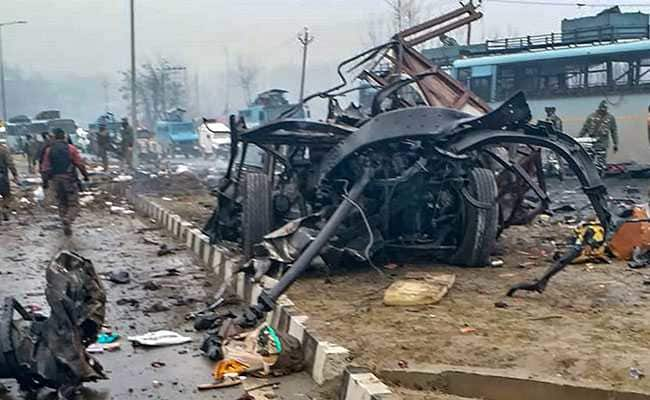
There is war talk all around. The war cries that have been an intrinsic feature of some television studios for about the past five years have become shriller during the past couple of days. Calling for a full-fledged war including the use of nuclear weapons is expected of some television anchors, hatemongers and shouting brigades know for screaming, screeching and yelling from the safe harbours of television studios for adding points to their television rating (TPR). Nevertheless, it is disturbing, when some seasoned diplomats and journalists, who understand wars are no answers to the political problems join the war choruses. To see people like Vinod Sharma, political editor of the Hindustan Times, who also visited Kashmir as part of a delegation of peace activists led by senior Congress leader Mani Shankar Aiyar who besides others had called on Syed Ali Shah joining the war crying brigade is worrisome. On Facebook, on Friday, he wrote, “The Pulwama terror attack is worse than what happened at Uri. So the Indian response to it has to be bigger than a surgical strike. It has to be thought through, not rushed into, for the desired military results, as opposed to political benefit in the election season.” Barkha Dutt, seeing the Lethipora, Pulwama ‘as an act of war’ in an article in the Washington Post wrote, “There will almost certainly be a strong military response from India.” However, in Indian media, there have been some saner voices like Ravish Kumar who have been counselling against any “kneejerk reaction.”
The attack by a suicide bomber on the heavily guarded convoy of the Central Reserve Police on Srinagar-Jammu highway patrolled round the clock since 1989, has been first of its kind in as much as the loss of life of troops is concerned. The gruesome incident killing forty-nine soldiers and wounding thirty others in the attack was bound to send shockwaves all-over India. The attack has not only raised some crucial questions about the BJP government’s Kashmir policy but also put it in the dock at a time when the election for the 17th Lok Sabha just a couple of months away. Moreover, the party has lost three states to Congress in 2018 Assembly election and is suffering terrible anti-incumbency, that certainly was going to take its toll in the coming elections. The immediate fallout of the incident was the already bitter relations between New Delhi, and Islamabad dipped further. India withdrew the ‘most favoured nation’ status given to Pakistan in trade services in 1996 accorded under WTO’s General Agreement on Tariffs and Trade (GATT). The two countries are signatories to this. New Delhi is not stopping at this only, Finance Minister Arun Jaitley, warned that India would deliver an “unforgettable lesson” in retaliation. Commenting on the emerging scenario after the highway attack, defence analyst Ajai Shukla in an article on BBC website wrote, “The Indian military has acknowledged contingency plans exist for punishing Pakistan more severely in the event of a damaging terrorist attack. But all such plans carry the danger of retaliation and uncontrolled escalation. This fear is exacerbated by the fact that both countries possess nuclear weapons. Pakistan has repeatedly signalled it would not hesitate to use them.”
The killing of soldiers’ form part of the endless cycle of suffering that has torn apart the state since the birth of dispute over its future. The agony and pain suffered by the people of the state during the past thirty years are virtually unparalleled in its recent history. The killing of 49 CRPF personnel is as ghastly as those of seventy men and women killed on 21 May 1990, when troops had fired on the funeral procession of Mirwaiz Molvi Mohammad Farooq and the macabre enacted in Sopore on 6 January 1993 when 55 civilians were killed in the town by BSF – some roasted alive inside their shops torched by men in uniform. These just two classic examples- the history of the past thirty years is soaked in blood.
Instead, of talking ‘vengeance’, ‘hot-pursuit’, ‘catch and kill’ and ‘pound of flesh’, ‘there is need to take the bull by the horns and address the seventy years dispute through peaceful dialogue. History testifies that these phrases have not helped in the past and are not going to help in future. That dialogue was the only way forward, two former Prime Minister’s Atal Bihari Vajpayee and Dr Manmohan Singh had very rightly understood it. There can be no two opinions that despite one after another setback Vajpayee pursued his goal of achieving peace in the region through dialogue. The 2001-2002 military standoff, which had brought armies of India and Pakistan face to face along the eight hundred kilometre Line of Control (LOC), the Working Boundary in Jammu and Kashmir had not dampened the urge for peaceful resolution of the outstanding issues including Jammu and Kashmir in the former NDA Prime Minister. Immediately, after the end of the military standoff, the two countries signed a comprehensive ceasefire agreement in November 2003. The agreement brought peace to almost three million people living on both the sides of the line dividing two parts of Jammu and Kashmir for nearly ten years. True, Vajpayee government did not live to see permanent peace returning to South Asia, but he will be remembered for his desire for peace in the region, 2003 ceasefire agreement and composite dialogue with Islamabad. The initiative did not die with the fall of the NDA government. The UPA government led by Manmohan Singh carried it further. One of its most significant achievement was opening of the Srinagar-Muzaffarabad road, popularly known as the Jhelum Valley Road, and the opening of this road to this day is counted as the biggest CBM, – an important step towards for finding an acceptable solution for all the three contending parties to the Dispute.
Equally, it is a reality even accepted by those who were opposed to Musharraf formula on Kashmir that these developments had a direct bearing on the ground situation; the militancy was relegated mainly to the background, and there was a paradigm shift from armed resistance to non-violence movement. The summers of dissent of 2008, 2009 and 2010 that were triggered by the myopic and bad decisions and inhuman actions of government were classic examples of non-violent movement in the state. How gun that had almost disappeared from the scene returned, needs no rocket science to understand, even a child on Srinagar street has an answer for the question.
Let me end this column quoting a few lines from an open letter to Prime Minister, Modi by Admiral L. Ramdas former Chief of Naval Staff written in the context of Pathankot and Uri Attacks. “Over the years successive Indian governments since 1948 have failed to find a solution for Kashmir. Recent events, including the violence and unrest in the valley, has further reinforced what many have been saying, that there can be no military solution to the Kashmir problem. Peace can only be restored through a dialogue leading to a political solution.”
Z. G. Muhammad is a columnist















































